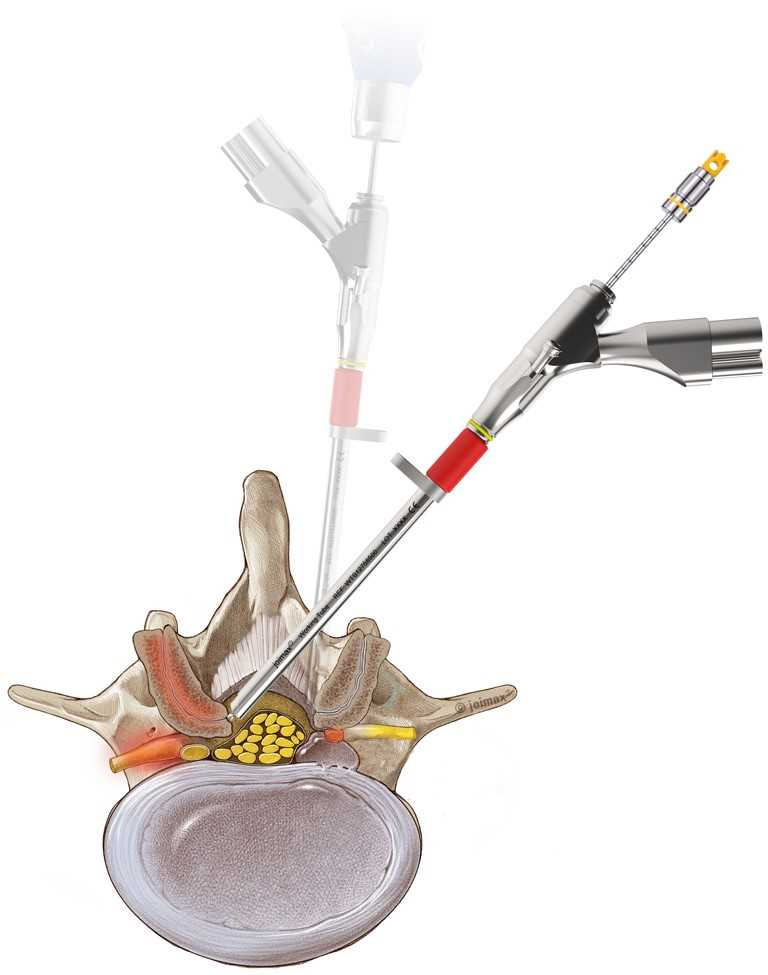Endoscopic Discectomy

Endoscopic Micro-invasive discectomy
An endoscopic micro-invasive microdiscectomy is a minimally invasive endoscopic surgery that allows direct visualization of the disc and the nerves. This procedure is used for decompressing nerve roots damaged by compressed spinal discs. It is usually indicated in patients with a herniated or compressed lumbar disc, who have not found adequate pain relief with pain management injections or conservative treatment. Or, the pain after a pain management injection returns rapidly and the pain is intolerable.
Many patients who suffer from sciatica, referred pain down either legs, and/or low back pain may be a candidate for this procedure. This procedure can also help in relieving pain associated with spinal stenosis and low back arthritis.
What is an endoscopic micro-invasive discectomy?
An endoscopic microdiscectomy is a minimally invasive endoscopic surgery that allows direct visualization of the disc and nerves. This procedure is used for decompressing nerve roots damaged by compressed spinal discs. It is usually indicated in patients with a herniated or compressed lumbar disc, who have not found adequate pain relief with pain management injections or conservative treatment.
Many patients who suffer from sciatica, referred pain down either legs, and/or low back pain may be a candidate for this procedure. This procedure can also help in relieving pain associated with spinal stenosis and low back arthritis.
Benefits associated with a Micro-invasive endoscopic discectomy
- Least invasive technique – less trauma to muscles and soft tissue than with traditional open surgery
- Fast recovery time
- Minimal pain or discomfort following the surgery
- Immediate leg pain relief in most cases
- Fewer complications and risks than open spine surgery
- Small incision and minimal scar tissue
- High success rate and sustained success of the therapy
- No or minimal blood loss
- No hardware placement or loss of mobility
What are the indications for an endoscopic micro-invasive discectomy?
- Compressed disc, usually with herniation that is causing back or leg pain, or neurological symptoms
- Failure of more conservative treatments, including pain management injections, to provide sufficient long term relief
- High suspicion of discogenic cause on imaging or by diagnostic procedures
What are the details of the endoscopic micro-invasive discectomy surgery?
Micro-invasive, endoscopic microdiscectomy requires a small incision, usually no larger than 1 cm, and x-rays to gain access to the lumbar spine.
Under x-ray guidance, a series of muscle dilators are used to stretch soft tissue, instead of cutting muscles, and create a path for the endoscope. Special instruments can also be used to shave down arthritic bone that may also be compressing a nerve. Once placed, the endoscope allows the physician to use direct visualization of the disc, nerve, and other structures and to safely remove problematic disc, freeing up the nerves.
Usually done under monitored anesthesia care, meaning you’re awake and responsive, but comfortable throughout the
procedure.
Unlike traditional open surgery, in which muscles, ligaments, and even and bones might be severed to reach the specified area; endoscopic microdiscectomy uses an endoscope, or small camera, to magnify the area where the microdiscectomy will be performed. Through the use of this technique only a small portion of the herniated disc that is compressing the spinal nerve needs to be removed.
What to expect after the procedure?
While this is an outpatient surgery, we do recommend resting for a prescribed period post-operative and then gradually increasing activity levels with instruction and supervision by your providers. You will also be advised to wear a back brace for added support during the healing process.
REQUEST APPOINTMENT
If you are suffering from low-back pain, neck pain, herniated disc, sciatica, pinched nerve and have been researching minimally invasive spine surgery as well as laser spine surgery, schedule an appointment to speak to Dr. T and Microspine Team today.
Microspine
Office
14300 N Northsight Blvd, #213. Scottsdale, AZ 85260
Phone: 602-833-2141
Fax: 602-610-3878
Office hours M-F: 8 AM to 5 PM
By appointment only
Dr. T serves the areas of Anthem, Apache Junction, Avondale, Buckeye, CasaGrande, Cave Creek, Chandler, Flagstaff, Fountain Hills, Gilbert, Glendale, Goodyear, Laveen, Maricopa, Mesa, Paradise Valley, Payson, Peoria, Phoenix, Prescott, Prescott Valley, Queen Creek, Safford, SanTan, Scottsdale, Sedona, Showlow, Suncity, Suncity West, Tempe, Tucson, Yuma, and surrounding areas.
